In the fresh produce industry, waste isn’t just an unfortunate byproduct. However, it poses a serious operational and financial threat. With slim profit margins and perishable inventory, even minor inefficiencies in storage, handling, or distribution can quickly turn viable produce into unrecoverable losses.
According to the Food and Agriculture Organization (FAO), nearly one-third of all food produced globally, roughly 30% is wasted due to poor handling and inefficient stock management. The impact is even more severe in advanced markets like the U.S., where an estimated 60 million tons of food, representing 30–40% of the total supply, is discarded annually.
For fresh produce operators, this level of waste results in real-time financial losses, operational instability, and increased regulatory pressure. Every misstep, including delayed receiving and improper rotation, drives spoilage, stockouts, and lost revenue.
This is where Fresh Produce Inventory Management becomes a strategic differentiator. By combining modern technologies like farm inventory management software, with disciplined processes, businesses can minimize waste, boost accuracy, and ensure full traceability, transforming inventory control from a reactive task into a proactive engine of profitability and compliance.
The Unique Challenges of Fresh Produce Inventory Management
Managing inventory for fresh produce isn’t like handling standard retail goods. It comes with its own set of challenges. To build systems that work, you need to understand what makes them so different:
1. Perishability Creates Time Pressure
Fresh produce doesn’t just expire, but it constantly changes in quality, often within days or even hours. This rapid perishability directly impacts how inventory must be managed. Products like leafy greens might last a week, while berries can spoil in just three days. In this context, relying on weekly or even daily system updates isn’t enough.
To reduce waste, inventory systems must support real-time FIFO or FEFO (First Expired, First Out) strategies that prioritize products nearing the end of their shelf life. Without dynamic rotation logic, older inventory can easily be overlooked, leading to spoilage, write-offs, and stockouts of fresher items.
Environmental factors, such as temperature fluctuations or improper handling, further exacerbate the issue by accelerating deterioration. That means your system needs to track product condition, not just quantity, and alert teams when the freshness window is closing. Without this visibility, even well-stocked shelves can become a liability rather than an asset.
2. Seasonal Demand Volatility
In fresh produce, demand isn’t steady. It shifts with seasons, weather, and market trends. A surge in summer fruit demand or a holiday spike in leafy greens can lead to rapid fluctuations in stock. For inventory managers, this unpredictability makes accurate forecasting a moving target.
Traditional forecasting models struggle to keep pace with short product lifecycles and rapidly changing consumer preferences. Overestimating demand can lead to spoilage and waste, while underestimating it can result in stockouts and missed sales opportunities. That’s why inventory systems for fresh produce need adaptive forecasting tools that incorporate seasonality, regional buying behavior, and historical trends to maintain balanced stock levels year-round.
3. Regulatory Compliance Requirements
Inventory management in fresh produce isn’t just about tracking stock. It’s about proving where it came from, how it was handled, and where it went. Regulatory frameworks, such as the FDA’s FSMA, require batch-level traceability, meaning your system must log every movement and status update in real-time.
This level of compliance goes beyond location tracking. Your inventory system must automatically link each lot to quality checks, temperature logs, and supplier credentials. When a food safety issue arises, being able to trace affected products within minutes, not days, is critical for both legal compliance and consumer safety.
Without tightly integrated traceability features, even a small data gap can lead to delays in recalls, failed audits, or substantial fines, rendering compliance a significant operational risk.
Proven Fresh Produce Inventory Management Strategies and Tools for Maximum Freshness and Minimal Waste

Fresh produce inventory management isn’t just about tracking numbers but about preserving product quality, ensuring profitability, and staying compliant in a highly volatile, perishable market.
The right combination of fresh produce inventory management strategies and tools can significantly reduce waste, enhance stock accuracy, and facilitate informed decision-making throughout the agricultural supply chain. Below are the essential methods modern produce operators are using to gain control and stay competitive:
1. Real-Time Inventory Monitoring for Immediate Visibility
Static, periodically updated systems leave gaps that lead to overstocking, stockouts, and unnecessary waste. Real-time inventory monitoring bridges those gaps by offering continuous visibility into stock levels, locations, and conditions.
With barcode scanning, RFID tags, and mobile integration, every movement from receiving to storage to shipment is tracked instantly. This immediate data allows for proactive action. For example, low stock on fast-moving items like strawberries can trigger automated reorders, while early signs of spoilage can prompt accelerated sales or redistribution, avoiding waste before it starts.
2. Enforcing FIFO and FEFO with Automation
First In, First Out (FIFO) and First Expired, First Out (FEFO) are essential principles in produce handling. FIFO ensures older products are sold first, while FEFO prioritizes those nearing expiration, regardless of arrival time.
Execution depends on lot-level tracking, date coding, and organized storage systems. Advanced inventory tools simplify this process by automatically generating pick lists based on expiry data, quality scores, and demand forecasts, ensuring optimal freshness and minimal loss without requiring manual effort.
3. Data-Driven Demand Forecasting
Demand for fresh produce is dynamic, influenced by factors such as weather, holidays, and promotions. Relying solely on historical sales data is no longer sufficient.
Modern systems integrate external data, such as weather patterns, local events, and market trends. Machine learning algorithms can then predict shifts in demand. For example, a cold front increases demand for soup vegetables or promotions to boost avocado sales. This minimizes both surplus and shortage, keeping your inventory balanced and waste to a minimum.
4. Lot and Batch Traceability for Compliance and Risk Control
Traceability isn’t just a regulatory checkbox. It’s a vital operational safeguard. Systems with lot and batch tracking connect each product to its origin, quality checks, storage data, and handling history.
This allows you to swiftly identify and isolate affected inventory during quality issues or recalls. It also enables performance benchmarking across suppliers and storage methods, revealing inefficiencies and helping you source smarter and store better.
5. Automated Reordering and Smart Threshold Alerts
Manual reordering is prone to delays and human error. Automated systems use real-time data, supplier lead times, and sales velocity to generate timely purchase orders.
Customizable freeze alerts notify managers when stock levels dip below safe thresholds, avoiding last-minute emergency orders and lost sales. Over time, these systems learn from trends and supplier reliability, adjusting reorder points and safety stock levels to match actual needs.
6. Temperature and Environmental Monitoring for Quality Control
Shelf life depends heavily on storage conditions. Automated sensors continuously track temperature, humidity, and airflow, alerting teams to fluctuations before they impact product integrity.
By connecting storage data with inventory systems, you can flag at-risk inventory for quick action—either by accelerating sales, rerouting, or prioritizing inspection. Historical data also informs smarter storage decisions, helping optimize layout and conditions for high-risk SKUs.
7. Analytics Dashboards for Continuous Improvement
Fresh produce inventory management requires ongoing insight and attention. Dashboards visualize KPIs such as waste by product category, forecast accuracy, inventory turnover, and audit readiness.
Detailed reports help uncover root causes of inefficiencies. For instance, consistent waste from a particular supplier or underperforming product lines. These insights support more innovative procurement, improved handling processes, and long-term cost reduction.
The Role of ERP in Reducing Waste and Improving Accuracy for Fresh Produce
In fresh produce operations where profit margins are razor-thin and spoilage risks are constant, inefficiencies at any point in the supply chain can result in significant losses. For growers, delays in harvest tracking can lead to missed freshness windows.
Packers face challenges in aligning incoming produce with fluctuating retail demand, while distributors must ensure timely delivery without compromising quality. To stay competitive, each of these players is adopting specialized fresh produce inventory management systems tailored to their specific operational needs and the industry’s fast-paced nature.
Unlike traditional fresh produce inventory management systems that treat all goods the same, produce-specific ERP platforms address the unique complexities of perishability, traceability, compliance, and labor intensity, ultimately helping to reduce waste, boost accuracy, and improve overall operational agility.
Unified Data Flow for Smarter Inventory Control
Fresh produce inventory management systems integrate all inventory functions from procurement and receiving to storage and shipping into a centralized platform. This real-time data flow eliminates the silos that often exist between departments, preventing miscommunications, double entry, and critical delays.
For instance, when a load arrives, the system simultaneously logs its temperature, updates inventory, and triggers automated quality checks, saving time and minimizing spoilage risk. Folio3 AgTech Fresh Produce ERP Software excels in this area by providing seamless connectivity between the field, warehouse, and distribution centers.
With features like real-time harvest tracking, cold chain monitoring, and automated alerts for temperature deviations, the software ensures that produce remains within optimal storage conditions from harvest to shelf.
Built-In Produce-Specific Functionality
Fresh produce isn’t like other inventory. It degrades quickly, varies by season, and demands precise handling. That’s why general ERPs fall short. In contrast, purpose-built systems like Folio3 AgTech Fresh Produce ERP Software include catch-weight processing, FEFO (First Expired, First Out) inventory logic, shelf-life estimators, and temperature-integrated storage control.
These tools don’t just improve traceability, they actively reduce waste. For example, by utilizing real-time data and shelf-life tracking, teams can prioritize the movement of time-sensitive stock, thereby reducing losses due to overripening or delayed shipments. Meanwhile, advanced quality grading tools let users capture defects and grades by lot, providing better control and insight during inspections and audits.
Actionable Insights with Real-Time Decision Support
In the fresh produce industry, decisions need to be made quickly. Leading ERP solutions for fresh produce inventory management help managers with real-time dashboards and predictive analytics that analyze historical trends, current quality scores, and even weather conditions to inform decisions on harvest timing, dispatch schedules, and promotional strategies.
Folio3 AgTech Fresh Produce ERP Software supports this level of agility through AI-driven forecasting tools and mobile-enabled dashboards that surface live data from every node of the supply chain. Whether it’s a sudden quality dip or a spike in demand, stakeholders can act quickly and with confidence.
Compliance Made Easy and Smooth
Food safety regulations such as FSMA, GFSI, and SQF require extensive documentation and traceability. Instead of treating compliance as a manual, post-hoc process, fresh produce ERP systems capture necessary data in real-time to manage audits, recalls, and reporting.
Folio3 AgTech Fresh Produce ERP Software streamlines this process with features such as export compliance modules, built-in recall traceability, and digital quality logs. When auditors request tracebacks or reports, teams can generate them within minutes, not days, saving time, stress, and potential revenue loss.
Implementing Inventory Management in Fresh Produce ERP – A Step-by-Step Guide
Implementing fresh produce inventory management within a fresh produce ERP system is about aligning technology with the real-world pace and perishability of produce operations. From the receiving dock to shipment, every step in your inventory workflow needs precision, speed, and traceability.
Here’s a focused roadmap for setting up inventory management inside your ERP to reduce waste, boost accuracy, and maintain complete control.
1. Map Current Inventory Flows and Identify Waste Hotspots
Start by auditing your entire inventory lifecycle from receiving and storage to picking and shipping. Create a visual map of where inventory is moved, changes hands, or undergoes a change in condition. Pinpoint areas where most shrinkage, spoilage, or inaccuracies occur. Go deeper by analyzing:
- Where and when deterioration happens (e.g., cold storage lapses, prolonged holding times).
- Handling errors or bottlenecks in the workflow.
- Supplier inconsistencies in delivery timing, quality, or packaging.
This baseline analysis not only helps prioritize improvements but also creates benchmarks for measuring post-implementation gains.
2. Segment SKUs Based on Risk, Waste, and Movement
Not all SKUs require equal attention. Use ABC or XYZ analysis to classify products by:
- Waste potential (perishability, shelf life).
- Sales velocity.
- Profit contribution.
This segmentation helps customize your system setup, handling protocols, and alert settings for maximum efficiency. For example:
- Category A: High-volume, high-risk items (like berries) that need real-time monitoring
- Category B: Moderate-turnover items with medium spoilage risk
- Category C: Low-velocity, long-shelf-life items requiring basic oversight
3. Establish Smart FIFO / FEFO Logic per Product Type
FIFO (First-In, First-Out) and FEFO (First-Expired, First-Out) are essential for reducing waste and maintaining freshness using waste management solutions, but they must be configured with precision.
- Assign FIFO/FEFO rules by SKU based on shelf life, product sensitivity, and customer requirements.
- Integrate these rules into your ERP’s picking and shipping workflows.
- Automate pick lists and replenishment based on these rotation priorities.
Support automation with clear labeling, date coding, and structured storage layouts for physical processes. Reinforce with team training and periodic audits.
4. Configure Your ERP System to Get Alerts, Dashboards, and Automation
Test everything in a pilot environment before deploying it fully. Ensure that notifications are actionable and that data is clean, relevant, and easily interpreted by every team member. Set up your ERP with smart parameters and user-specific dashboards:
- Alerts: Trigger low-stock, temperature deviation, or near-expiry warnings
- Dashboards: Customised for each role, managers, procurement, QC, and leadership.
- Automation: Enable predictive reordering based on sales trends and supplier lead times
5. Train Staff on Mobile Workflows, Scanning, and Receiving Best Practices
Technology is only as good as the people using it. Create SOPs, quick-reference guides, and troubleshooting manuals. Use real products in live simulations to build confidence. Ongoing refresher training ensures that your team stays up to date as the system evolves. Conduct targeted training on:
- Mobile audits and barcode scanning.
- Best practices for receiving and quality checks.
- Traceability procedures for compliance and recall readiness.
6. Monitor KPIs Weekly by Refining Reordering, Par Levels, and Supplier Inputs
Post-implementation success depends on continuous optimization. Monitor key metrics such as:
- Waste percentage by SKU.
- Inventory turnover and forecast accuracy.
- Supplier delivery timeliness and product quality.
Frequent reviews help prevent drift and align inventory management with real-world performance trends. Use these insights to:
- Adjust par levels and reorder thresholds.
- Recalibrate forecasting models.
- Share performance data with suppliers to improve consistency.
7. Run Routine Cycle Counts and Reconciliation Audits
Cycle counts validate system accuracy and flag gaps in process or compliance. Focus more frequently on high-waste or high-velocity products.
These audits are critical for maintaining trust in your system and building a culture of accountability. For best results:
- Rotate count schedules weekly or monthly.
- Investigate discrepancies and track recurring issues.
- Conduct reconciliation audits that ensure all inbound, outbound, and waste events are properly logged.
Conclusion
Effective fresh produce inventory management goes beyond simple tracking. It’s a strategic capability that reduces waste, ensures compliance, and drives profitability. With fresh produce among the top food categories wasted in the U.S., the need for more intelligent systems is urgent.
By adopting the right processes and technology, businesses can minimize losses, increase accuracy, and enhance their supply chain resilience. That’s where Folio3 AgTech Fresh Produce ERP Software comes in, offering real-time visibility, automated traceability, and customizable alerts explicitly designed for the unique challenges of fresh produce operations.
If you’re ready to move from reactive inventory control to proactive optimization, Folio3 AgTech Fresh Produce ERP Software can help you turn waste into value.
FAQs
How Quickly Can A Fresh Produce ERP System Show ROI?
Most fresh produce operations see positive ROI within 6-12 months through reduced waste, improved accuracy, and labor efficiency. The exact timeline depends on current waste levels, system complexity, and the effectiveness of implementation.
What’s The Biggest Challenge In Implementing Fresh Produce Inventory Management Systems?
Change management and staff training typically present the most significant challenges. Technical implementation is usually straightforward, but changing established procedures and building new habits requires sustained effort and clear leadership.
Can Small Fresh Produce Operations Benefit From Advanced Inventory Management Systems?
Yes, but the approach differs from large operations. Small operations should focus on core functionality, such as FIFO management, basic traceability, and simple forecasting, before adding advanced features like automated reordering or complex analytics.
How Do Inventory Management Systems Handle Seasonal Demand Variations?
Advanced systems utilize historical data, seasonal patterns, and external factors, such as weather forecasts, to automatically adjust inventory parameters. They can modify reorder points, safety stock levels, and forecast algorithms based on seasonal patterns.
What Integration Capabilities Should I Look For In A Fresh Produce Inventory Management System?
Look for fresh produce inventory management systems that integrate with your existing accounting software, POS systems, and supplier platforms. EDI capabilities, API access, and standard data formats ensure smooth information flow across your entire operation.







